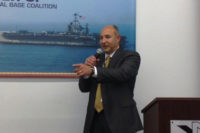For residents of Prairie du Sac, Wis., one of the largest nearby bodies of water to enjoy is Lake Wisconsin — a 10,000-acre lake with 52 miles of shoreline.
On May 8, employees from Milwaukee Valve’s manufacturing plant in Prairie du Sac got an interesting opportunity to see how important the valves they create are to the U.S. Navy’s fleet.
A corporate team from Newport News Shipbuilding, builders of some of the U.S. Navy’s major aircraft carriers and submarines, toured the plant and then held a question-and-answer session with about 150 Milwaukee Valve employees.
NNS President Matt Mulherin addressed the crowd and spoke highly of Milwaukee Valve’s operations and staff.
“I thought I was a valve guy, but I guess right-tighty, lefty-loosey was all I knew,” Mulherin joked. “This was more than I expected. It’s amazing. These are works of art and you should be proud of what you do here.”
Mulherin told the crowd that NNS was currently seven years into building the newest Gerald R. Ford aircraft carrier — and that it’s still two years away from completion. This fact drew an audible gasp from the assembled crew. The shipbuilders also are in the process of building a Virginia class submarine and a John F. Kennedy aircraft carrier — all projects that will use Milwaukee Valve products.
“We like to say, ‘We’re 100 tons of diplomacy,’” Mulherin said.
Regarding the long-term planning of building a ship, Mulherin added: “We develop a plan and then work to that plan.”
Milwaukee Valve employees also asked thoughtful questions regarding the lifecycle of these massive ships and their products that get installed.
“An aircraft carrier has about a 50-year lifespan,” Mulherin added. “It comes in for a one-time nuclear refuel at 25 years. It’s why the quality of the products you make is required.”
In an exclusive interview with pme (available in the pme Network Videos section), Milwaukee Valve President and CEO Rick Giannini said the standards and processes for the valves used by the Navy and NNS are the same as what an engineer will see from the company in the standard commercial market.
“(The parts) come from the exact same foundry through most of the same machines and the same people,” he said. “That quality standard required from the Navy is in every valve.”
Giannini explained that there are some minor differences, though.
“When it gets to the end of the process we have what we call a resident QAR,” he stated. “He’s a quality inspector on staff and he’s part of the government. He’ll come and check, depending on what type of product it is or where it’s going to be used on a ship, and independently verify that it’s been properly built. In fact, he might inspect throughout the process too. He’ll hop on a machine or in final assembly.”
Mulherin added that seeing the plant in action was exciting.
“We wanted to come out and talk with Rick, see the facility and understand the investments,” he said. “They really provide a first-class product. I came out and sort of had an expectation and I was blown away. I was floored by what I saw. The people here are tremendous and the facility is amazing. I learned a lot. I think I got more out of it than they did.”



